|
|
| home | features | exhibitions | interviews | profiles | webprojects | gazetteer | links | archive | forum |
|
Radical Nature: Art and Architecture For a Changing Planet, 1969-2009 Barbican, London, 19/6/09 - 18/10/09
But this overdue survey of environmental art featuring 25 artists or collectives, from the big hitters of the Land Art movement to idealists and environmental crusaders is a perfect fit for London’s Barbican centre. Built 27 years ago, and blown in on the same optimistic wind of Sixties idealism that gave birth to Land Art, the Barbican, all mass concrete and architectural ‘brutalism’ provides an oasis of calm amidst the urban sprawl; a contrasting backdrop against which to consider our relationship with nature.
Providing the centre-point of the exhibition is the work of Richard
Buckminster Fuller, presented as the unlikely grandfather of the Land Art movement.
Inside a wooden geodesic dome plays Modelling Universe
(1976), a beautifully shot 15-minute interview in which the
architect explains his philosophies and life’s work. Sharing
his joy and wonder in nature and the universe Fuller explains; ‘I’m
not trying to imitate nature, I’m trying to discover
The latter are the
inspiration for I Am So Sorry. Goodbye (2008) created outside
in the Barbican courtyard by the British partnership Heather and
Ivan Morison. The wooden structure consists of two interconnecting
domes constructed from tessellated triangles, roughly clad with
split logs and built using the same principles as Fuller’s dome.
Inside there are tables and stools fashioned from logs and an
invigilator serving hibiscus tea
If some artists in
this exhibition explore the serendipity found when humans understand
and work with nature, others refer to what happens when we don’t.
American artist Mark Dion’s Mobile Wilderness Unit – Wolf
(2006) is a comment on our dangerous detachment from nature and the
arrogance of believing we can treat it as a commodity. An artist
interested in taxonomy and classification, Dion displays a stuffed
wolf on a small open trailer; shiny silver, clean and utterly man
made. The wolf stands on fake grass, moss and shrubbery – a pathetic
recreation of its natural habitat. With no glass case surrounding
the work, the viewer can stand millimetres away from the wolf and
stare deep into its eyes. The effect is frightening and
Similarly Simon Starling’s Island For Weeds (2003) highlights the human capability for foolishness when it comes to nature. Imported into the UK as an ornamental beauty in the late eighteenth century, rhododendrons have become so invasive in Scotland that they are now seen as a weed. Starling presents a floating island, offering ‘space for the rejected plant to grow freely’. The rhododendrons rest in their own personal flowerbed - a metal tray with floats ready to be pushed out into a lake and anchored with chain weights and oil drums. Meter (2009) sees Scottish artist Anya Gallaccio bring an entire tree into the gallery – cut into sections, then reassembled and held in place with wire tethers, screws brutally rammed into the bark. Swedish artist Henrik Hakansson goes one step further and uproots an entire section of tropical rain forest. His Fallen Forest (2006) is tipped over so the trees appear to grow horizontally rather than vertically. Bringing nature into
an art gallery in this wholesale manner is certainly striking, but
perhaps not the most enduring demonstration of the human appetite
for environmental destruction. Expressing this with far more power
is LA based collective The Center For Land Use Interpretation (CLUI),
founded in 1994. The group exist to research and disseminate
information about land through databases, lectures, bus tours,
photographs and
The pipeline attracted much controversy when it was built in the early Seventies from environmental campaigners and native Alaskans, concerned both about wildlife and land rights. The film reveals that the public are not allowed access to the sea because of the oil drilling, while graffiti on the pipeline reads ‘You went too far north’. Although the text contains only bare facts about the pipeline, such as how many people work there and what shifts they do, the film grips and mesmerises with what seems like secret information, forcing us to question whether this is what’s best for the Alaskan wilderness. The exhibition also contains examples of artists who play with nature, where the environmental agenda is often more understated. Interventions and interactions include remnants of the Joseph Beuys piece Honeypump In The Workplace (1977), in which he pumped honey through plastic tubes using a motor lubricated by margarine. The transformative, energy giving properties of these materials attracted Beuys in much the same way that the texture and temporality of rocks attracted perhaps one of the most revered Land Art practitioners; Robert Smithson. Film documentation of his Spiral Jetty (1970), the huge 15 foot wide now salt encrusted rock coil he created in the Great Salt Lake, Utah, is shown here alongside Yucatan Mirror Displacement (1969) - fragments of mirror photographed against the diverse colours and textures found in the forest of Yucatan, Mexico. Also included is the early, less political work of the seminal German artist Hans Haacke; evolving pieces using liquids, seeds and animals. His mound of turf, Grass Grows (1969), is recreated here alongside photo documentation of work such as Ten Turtles Set Free (1970), in which he released endangered pet shop turtles back into the wild, Chickens Hatching (1969) and his Rhine Water Purification Plant (1972), which transformed the polluted water of the Rhine into water clean enough for goldfish to swim in.
Danish artist Tue Greenfort is perhaps the most playful practitioner exhibited here and the only one to investigate what happens when the tables turn and nature becomes dependant on the urban environment. His set of animal ‘self-portraits’, DaimlerstraBe 38 (2001), in which a frankfurter is planted as bait to lure a fox into detonating a hidden camera are a humorous delight. Adding a political dimension to artistic interventions in nature are R&Sie (n), Paris based architects who take their cue from artists like Haacke and Smithson to create structures that grow and evolve. Symbiosishood (2009) is a proposal to cover a former minefield on the border of North and South Korea with an invasive plant, so that the site of such destruction becomes invisible and boundaries are blurred. Shown here are drawings, a three dimensional digital animation and a scale model of the site. Human obsession with land owning and the prohibitive nature of planning permission is something that has increasingly concerned utopian groups and artists since the Sixties, with many who try to live at one with nature, such as the residents of Wales’s Teepee Valley and Tinker’s Bottom in Somerset being obstructed by the very governments who urge us to consume less and be more ecological. The Ant Farm collective, active in San Francisco between 1968 and 1978 and most famous for their line of Cadillacs half buried in the desert, imagined alternative extra-territorial structures, such as their floating Dolphin Embassy (1974-8). The artists promoted their idea of interspecies communication to both humans and dolphins. Documentation, including drawings of the structure, promotional booklets, clothing, pin badges and business cards are all on display, alongside photographs of their efforts. In one Jim Nollman and Nancy Caldewood float on a raft in the sea of Cortez, Mexico, 1977, playing instruments to the dolphins. In another Doug Michels explains the idea with the use of a sketchpad to a dolphin in a tank. If their ultimate aim for humans and dolphins to communicate through ‘psychic methods’ seems faintly laughable and rooted in the outdated hippy ideals of their era, thirty years on their basic notion of human harmony with nature is undeniably mainstream.
Argentinean Tomas Saraceno also seeks to transcend borders and the concept of a nation state through his visions of alternative, often floating, utopias. 3 x 12 MW (2007/9) is part of his ‘airport city’ concept, a conjoined network of cells that use solar energy to float. With no border restrictions Saraceno imagines a world where synergy is encouraged between people and nations. The giant floating bubbles, crossed with ropes and weighed down with other bubbles filled with water, hover deliciously against the massive concrete pillars running through the gallery space. Ideas about reclaiming land and taking on big business are nowhere better demonstrated than in Agnes Denes utterly breathtaking Wheatfield – A Confrontation (1982). The Hungarian artist planted and harvested two acres of wheat in New York, on land worth $4.5 bn, in the shadow of the city’s imposing financial district. Shown here are amazing photographs of the golden wheat juxtaposed against the statue of liberty and skyscrapers, including the twin towers. There are also beautiful conical ink drawings showing a fir forest planted by the artist in Finland – Tree Mountain (1992-96), but it is the astonishing image of Denes standing in the middle of her wheat field, staff in hand, the iconic New York skyline as her backdrop, which burns into the retina long after leaving the exhibition. The piece was recreated for this exhibition on wasteland in Dalston, east London.
The ideas of Denes and Laderman Ukeles are brought up to date with the work of Lara Almarcegui and Luke Fowler. Spanish Almarcegui offers a slideshow and pamphlet detailing the wastelands of the Lea Valley, currently being redeveloped for the 2012 Olympics, while Glaswegian Fowler exhibits Bogman Palmjaguar (2007) a 30 minute film of interviews with a man diagnosed as a paranoid schizophrenic who passionately campaigns on behalf of the now drying out Flow country peat bog in the far north of Scotland. The legacy of this exhibition is the work of Newton Harrison and Helen Mayer Harrison – a recreation of their 1972 piece Full Farm. As part of their commitment to only make work that benefits ecosystems, Full Farm is an installation of the crops needed to maintain a balanced diet. In raised wooden beds, tomatoes, beans, raspberries, courgettes, celeriac, beetroots and chard grow in orderly rows, whilst outside on the balcony a wild meadow has been planted for animals to feed on. In order to show the work, the Barbican had to agree to donate the garden to a local school after the exhibition closes. The piece is just one of the deeply moving, often joyful moments that radiate throughout the gallery.
text: Katie Toms installation photos: Lyndon Douglas 8/9/09 Tue Greenfort:Daimlerstrasse 38, 2001 Eight colour photographs Courtesy the artist and Johann König, Berlin Ant Farm: House of the Century, 1971–73 Private house Courtesy Ant Farm Photo: Ant Farm Agnes Denes: Wheatfield – A Confrontation, 1982 Two acres of wheat planted and harvested in Battery Park landfill, downtown Manhattan. Commissioned by Public Art Fund, New York CityPhotograph: © Agnes Denes. Courtesy the artist
|
|
|

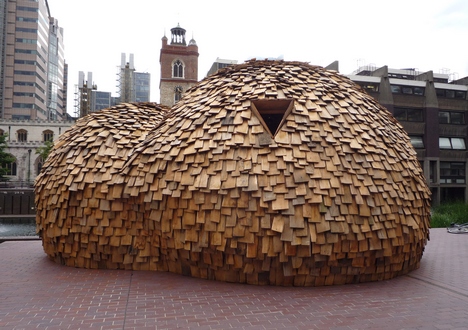 Mounting
an exhibition about the environment in one of the most built up, densely
populated areas of one of the most built up, densely populated cities in
the world may seem a provocative decision.
Mounting
an exhibition about the environment in one of the most built up, densely
populated areas of one of the most built up, densely populated cities in
the world may seem a provocative decision. 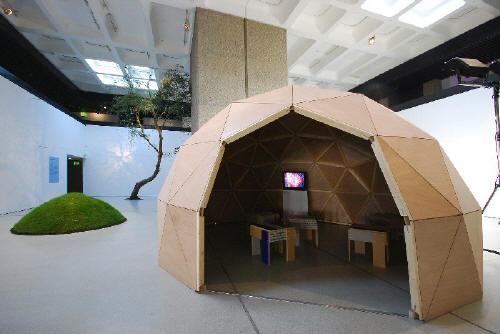
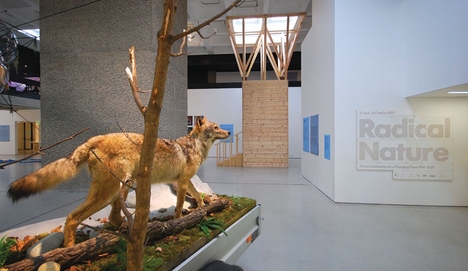 in
little white china beakers. Nine of the triangles are left open,
offering peepholes on to the lake and plants beyond. Designed as a
‘tea house’ this is the perfect hideaway to sit and chat or read to
the sound of nearby rushing water as sunlight reflects off the water
and ripples across the inside walls.
in
little white china beakers. Nine of the triangles are left open,
offering peepholes on to the lake and plants beyond. Designed as a
‘tea house’ this is the perfect hideaway to sit and chat or read to
the sound of nearby rushing water as sunlight reflects off the water
and ripples across the inside walls.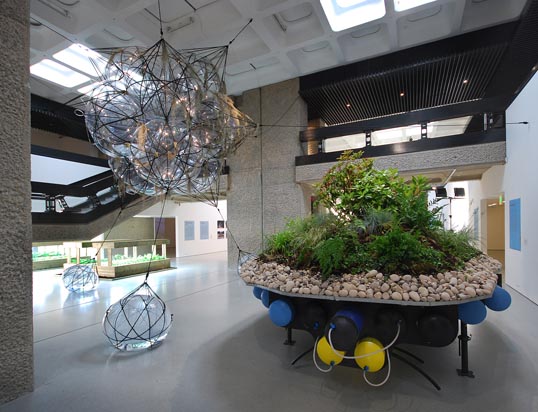 humbling;
a reminder that nature isn’t a part-time leisure pursuit featuring
Hunter wellies, tea lights and plastic garden chairs.
humbling;
a reminder that nature isn’t a part-time leisure pursuit featuring
Hunter wellies, tea lights and plastic garden chairs.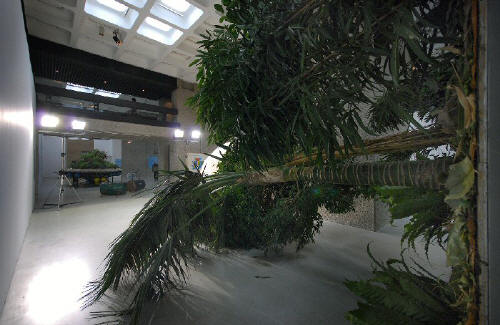
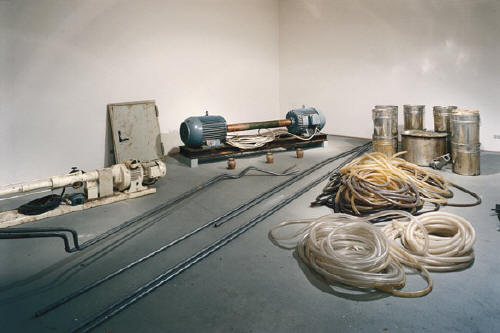
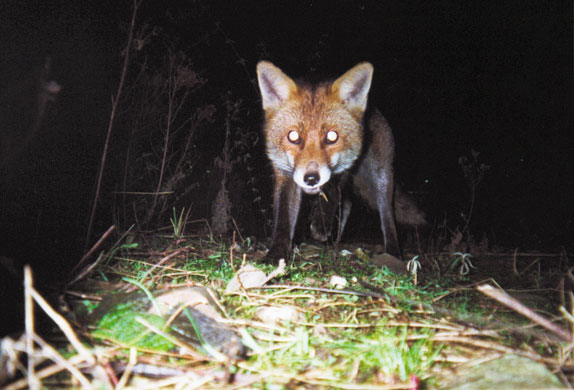
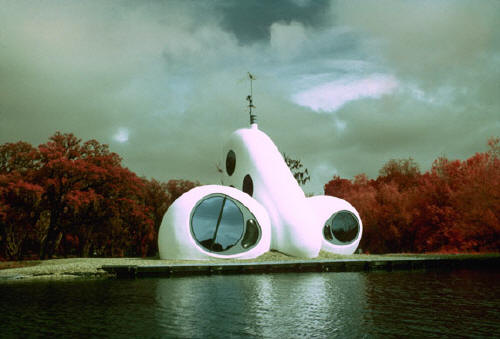
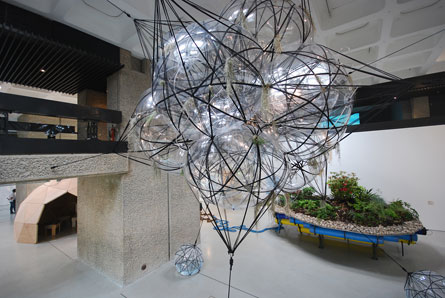
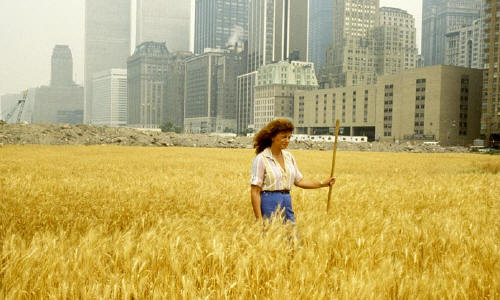 Operating
in New York at the same time as Denes was Mierle Laderman Ukeles.
Her manifesto to celebrate and explore everyday processes led her to
shake hands with every one of the city’s ‘sanmen’ and thank them
personally for their work dealing with the city’s sewage, in her
famous piece Touch Sanitation (1970-80). Exhibited here is
her letter to the workers. ‘Thank you for keeping New York city
alive!’ she writes, and invites the public to join her in thanking
the workers by waving whenever they see them.
Operating
in New York at the same time as Denes was Mierle Laderman Ukeles.
Her manifesto to celebrate and explore everyday processes led her to
shake hands with every one of the city’s ‘sanmen’ and thank them
personally for their work dealing with the city’s sewage, in her
famous piece Touch Sanitation (1970-80). Exhibited here is
her letter to the workers. ‘Thank you for keeping New York city
alive!’ she writes, and invites the public to join her in thanking
the workers by waving whenever they see them.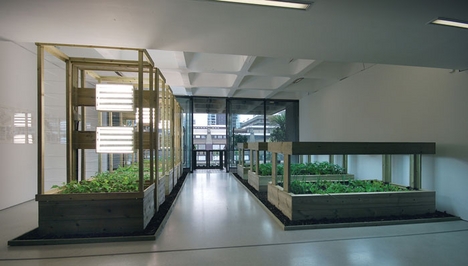 While
it may be short on ‘solutions’, by being open to the relationship
between art and nature in all its forms the Barbican has triumphed.
Radical Nature conveys not an angry, whining plea to recycle and
grow your own, but rather a sense of hope that the rural and urban
can be happy bedfellows, as long as we respect and understand that
ultimately nature is top dog. A concept that's not really so radical
after all. As Fuller advised; ‘To continue on this planet, humans
must comprehend the way nature works.’
While
it may be short on ‘solutions’, by being open to the relationship
between art and nature in all its forms the Barbican has triumphed.
Radical Nature conveys not an angry, whining plea to recycle and
grow your own, but rather a sense of hope that the rural and urban
can be happy bedfellows, as long as we respect and understand that
ultimately nature is top dog. A concept that's not really so radical
after all. As Fuller advised; ‘To continue on this planet, humans
must comprehend the way nature works.’